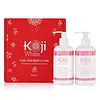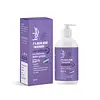What's inside
What's inside
 Key Ingredients
Key Ingredients

 Benefits
Benefits

 Concerns
Concerns

 Ingredients Side-by-side
Ingredients Side-by-side

Water
Skin ConditioningPropylene Glycol
HumectantIsopropyl Palmitate
EmollientOryza Sativa Bran Oil
EmollientGlyceryl Stearate
EmollientCetearyl Alcohol
EmollientDimethicone
EmollientParaffinum Liquidum
EmollientPhenoxyethanol
PreservativePEG-100 Stearate
Urea
BufferingXanthan Gum
EmulsifyingPEG-40 Hydrogenated Castor Oil
EmulsifyingParfum
MaskingChlorphenesin
AntimicrobialSodium Cetearyl Sulfate
CleansingKojic Acid
AntioxidantDisodium EDTA
Tocopheryl Acetate
AntioxidantCocos Nucifera Oil
MaskingOlea Europaea Fruit Oil
MaskingPanthenol
Skin ConditioningGlycerin
HumectantPolyglutamic Acid
Skin ConditioningButylene Glycol
HumectantHoney Extract
HumectantSoluble Collagen
HumectantHydrolyzed Elastin
EmollientSodium PCA
HumectantArbutin
AntioxidantCitric Acid
BufferingSodium Sulfite
PreservativeAcetyl Tyrosine
Skin ConditioningSaxifraga Sarmentosa Extract
Skin ConditioningSerine
MaskingGlycogen
HumectantPaeonia Suffruticosa Root Extract
Skin ProtectingAminopropyl Ascorbyl Phosphate
AntioxidantScutellaria Baicalensis Root Extract
AstringentGlutathione
Water, Propylene Glycol, Isopropyl Palmitate, Oryza Sativa Bran Oil, Glyceryl Stearate, Cetearyl Alcohol, Dimethicone, Paraffinum Liquidum, Phenoxyethanol, PEG-100 Stearate, Urea, Xanthan Gum, PEG-40 Hydrogenated Castor Oil, Parfum, Chlorphenesin, Sodium Cetearyl Sulfate, Kojic Acid, Disodium EDTA, Tocopheryl Acetate, Cocos Nucifera Oil, Olea Europaea Fruit Oil, Panthenol, Glycerin, Polyglutamic Acid, Butylene Glycol, Honey Extract, Soluble Collagen, Hydrolyzed Elastin, Sodium PCA, Arbutin, Citric Acid, Sodium Sulfite, Acetyl Tyrosine, Saxifraga Sarmentosa Extract, Serine, Glycogen, Paeonia Suffruticosa Root Extract, Aminopropyl Ascorbyl Phosphate, Scutellaria Baicalensis Root Extract, Glutathione
Water
Skin ConditioningSodium Benzoate
MaskingZinc Oxide
Cosmetic ColorantTitanium Dioxide
Cosmetic ColorantSesamum Indicum Seed Oil
EmollientCarica Papaya Fruit Extract
Skin ConditioningDipotassium Glycyrrhizate
HumectantOlea Europaea Fruit Oil
MaskingEDTA
Citric Acid
BufferingGlycerin
HumectantAloe Barbadensis Leaf Juice
Skin ConditioningButyrospermum Parkii Butter
Skin ConditioningMelaleuca Alternifolia Leaf Oil
AntioxidantSimmondsia Chinensis Seed Oil
EmollientEmulsifying Wax Nf
Cetyl Alcohol
EmollientStearic Acid
CleansingTocopherol
AntioxidantKojic Acid
AntioxidantLavandula Angustifolia Oil
MaskingNiacinamide
SmoothingAscorbic Acid
AntioxidantWater, Sodium Benzoate, Zinc Oxide, Titanium Dioxide, Sesamum Indicum Seed Oil, Carica Papaya Fruit Extract, Dipotassium Glycyrrhizate, Olea Europaea Fruit Oil, EDTA, Citric Acid, Glycerin, Aloe Barbadensis Leaf Juice, Butyrospermum Parkii Butter, Melaleuca Alternifolia Leaf Oil, Simmondsia Chinensis Seed Oil, Emulsifying Wax Nf, Cetyl Alcohol, Stearic Acid, Tocopherol, Kojic Acid, Lavandula Angustifolia Oil, Niacinamide, Ascorbic Acid
Ingredients Explained
These ingredients are found in both products.
Ingredients higher up in an ingredient list are typically present in a larger amount.
Citric Acid is an alpha hydroxy acid (AHA) naturally found in citrus fruits like oranges, lemons, and limes.
Like other AHAs, citric acid can exfoliate skin by breaking down the bonds that hold dead skin cells together. This helps reveal smoother and brighter skin underneath.
However, this exfoliating effect only happens at high concentrations (20%) which can be hard to find in cosmetic products.
Due to this, citric acid is usually included in small amounts as a pH adjuster. This helps keep products slightly more acidic and compatible with skin's natural pH.
In skincare formulas, citric acid can:
While it can provide some skin benefits, research shows lactic acid and glycolic acid are generally more effective and less irritating exfoliants.
Most citric acid used in skincare today is made by fermenting sugars (usually from molasses). This synthetic version is identical to the natural citrus form but easier to stabilize and use in formulations.
Read more about some other popular AHA's here:
Learn more about Citric AcidGlycerin is already naturally found in your skin. It helps moisturize and protect your skin.
A study from 2016 found glycerin to be more effective as a humectant than AHAs and hyaluronic acid.
As a humectant, it helps the skin stay hydrated by pulling moisture to your skin. The low molecular weight of glycerin allows it to pull moisture into the deeper layers of your skin.
Hydrated skin improves your skin barrier; Your skin barrier helps protect against irritants and bacteria.
Glycerin has also been found to have antimicrobial and antiviral properties. Due to these properties, glycerin is often used in wound and burn treatments.
In cosmetics, glycerin is usually derived from plants such as soybean or palm. However, it can also be sourced from animals, such as tallow or animal fat.
This ingredient is organic, colorless, odorless, and non-toxic.
Glycerin is the name for this ingredient in American English. British English uses Glycerol/Glycerine.
Learn more about GlycerinKojic acid comes from fungi and can also be from fermented foods. It helps even out skin tone and reduce hyperpigmentation.
This ingredient works by blocking tyrosine, an enzyme that starts the process of skin darkening.
Kojic Acid is antifungal and often used to treat fungal infections. Additionally, it can help fight bacteria with its antimicrobrial properties. This can help treat acne as well.
A similar ingredient is arbutin.
Learn more about Kojic AcidOlea Europaea Fruit Oil is the fixed oil obtained from the ripe fruit of the Olive. In other words - olive oil.
The primary contents of olive oil are glycerides of the fatty acids linoleic, oleic and palmitic.
Olive oil also contains antioxidants such as Vitamin E. Antioxidants may help reduce signs of aging by fighting unstable free-radical molecules. It also contains Vitamins A (retinol), D, and K.
The squalene in olive oil makes it a great emollient. Emollients help soothe and soften your skin by trapping moisture in. This makes olive oil a great skin moisturizer.
Studies show olive oil to have antibacterial and antifungal properties in low concentrations. Another study found olive oil irritated sensitive oily skin. We always recommend speaking with a professional about using this ingredient in your routine.
Due to the fatty acid content, this ingredient may not be fungal-acne safe.
Learn more about Olea Europaea Fruit OilWater. It's the most common cosmetic ingredient of all. You'll usually see it at the top of ingredient lists, meaning that it makes up the largest part of the product.
So why is it so popular? Water most often acts as a solvent - this means that it helps dissolve other ingredients into the formulation.
You'll also recognize water as that liquid we all need to stay alive. If you see this, drink a glass of water. Stay hydrated!
Learn more about Water